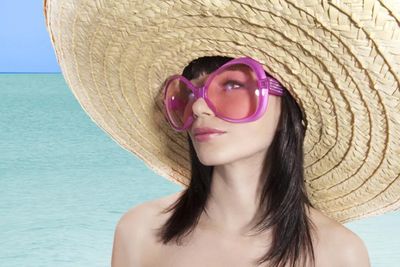Yesterday reminded me of why I love the sun so much. After an endless winter where the sun's warming effects felt minimal, the sun was finally out in full force. Its delightful warmth and light were just what I needed to restore my hope and remind me that warmer weather was finally within reach.
I craned my neck up toward the heat—and then I was suddenly reminded that in addition to worshipping the sun, we must also fear it.
The sun giveth, yet it also taketh away.
Lots of us know to protect our skin from exposure to the sun's harmful UVA and UVB rays, those invisible ultraviolet rays that cause sunburns and, in some cases, skin cancers. But what many people fail to realize is that the sun can also damage their eyes.
This damage can occur anytime during the year—not just when the sun feels hot. In addition, a cloudy day is no insurance that the sun won't harm: its rays can easily pass through haze and even thin clouds.
I'm not just talking about that premature wrinkling in the skin surrounding your eyes, but things of a much more serious nature: vision loss, cataracts, macular degeneration and eye and eyelid cancers. Why do these things occur? Skin on the eyelid is thin and fragile, easily damaged by UV light. Sure, the lens and cornea inside the eye can filter UV rays, but over time the absorption of the rays can be damaging, and that damage is cumulative, especially if you spend a lot of time outdoors.
Although everyone is at risk, people with fair skin and light eyes have to be especially vigilant, because they have an increased long-term risk.
What you can do to protect your eyes:
- Wear sunglasses that absorb or block UV rays—and wear them year-round, even on overcast days.
- To ensure you can see traffic signals (dark lenses may interfere with color recognition), check to see if the lenses meet ANSI and/or ISO standards.
- Lenses that are neutral gray, green or brown offer the most comfortable vision.
- Lenses that can absorb and block 99 percent to 100 percent of UVA and UVB light provide the best protection. Ideally they should also protect against HEV light (high-energy visible light in the violet/blue spectrum). HEV light may contribute to cataracts and can also damage the retina over time, leading to macular degeneration.
- Always check the labels or packaging to make sure you're getting the proper protection.
- As for size, make sure the glasses are large enough to cover your eyes, eyelids and surrounding areas. The best protection comes from wraparound styles that fit close to the face and contain UV-protective side shields.
- To minimize or eliminate glare in the water or snow, or while driving, look for polarized lenses.
- Eat right. Lutein and zeaxanthin, primarily found in green leafy vegetables like spinach and kale and orange and yellow-colored fruits and veggies, have been found to help support the health of your eyes. Vitamins C and E, zinc and omega-3 fatty acids also play a role in eye health. Other eye-healthy foods include corn, collards, green peas, papaya, grapefruit, almonds, pecans, vegetable oils and egg yolks.
You might also want to read:
10 Tips for Protecting Your Eyes
Protect Your Eyes From the Sun
The Unsafe Way to Wear Eyeliner


